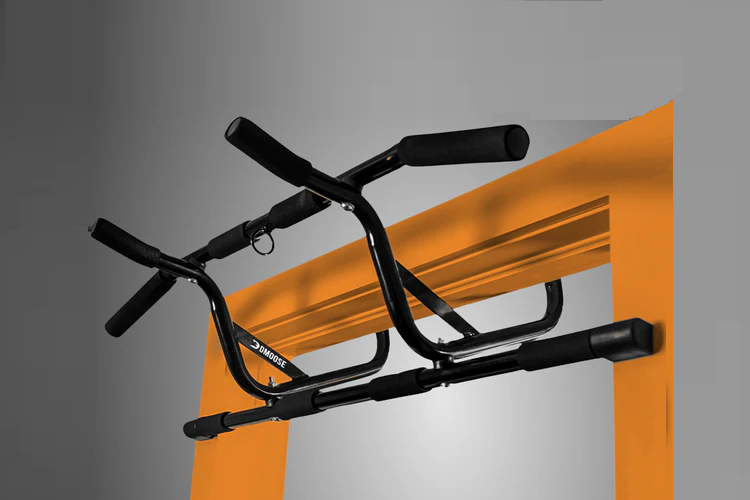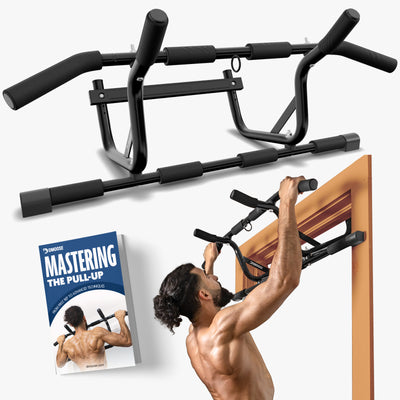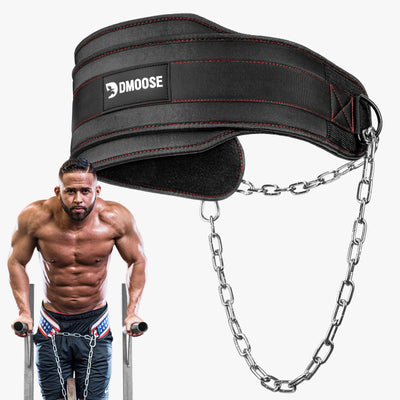If you've ever wondered how a pull up bar doorway works, you're not alone. It’s a common question for those new to using this piece of home gym equipment.
Despite its simplicity, there’s a lot of science behind how it stays securely in place, allowing you to perform exercises like pull-ups and chin-ups safely.
A doorway pull-up bar relies on key principles like tension, leverage, and weight distribution to stay secure during use. These mechanics are what prevent the bar from shifting or falling, even as you apply significant force during your workout.
In this guide, we’ll explain exactly how these principles work to keep your bar stable and how to get the most out of your workouts.
How Does a Doorway Pull-Up Bar Work?

A doorway pull-up bar may look simple, but it relies on a few key principles of physics to stay secure and functional. Understanding how these mechanics work can help you safely maximize your workouts. Here’s an in-depth look at how different types of doorway pull-up bars stay in place:
Tension Mechanics: How Tension-Mounted Bars Stay in Place
Tension-mounted doorway pull-up bars rely on the concept of pressure to remain stable. These bars use an adjustable system that creates tension between the pull-up bar and the doorway frame.
The tension is generated by twisting the bar to expand it, pressing the ends against the doorframe. This force keeps the bar securely in place, allowing it to hold the weight of the user during exercises like pull-ups and chin-ups.
The more pressure you apply during setup, the firmer the bar grips onto the doorframe, preventing it from shifting or falling.
However, it’s crucial to ensure that the bar is properly set up with the right amount of tension—too little and it could slip, too much and it may damage the doorframe. Regular checks are important to maintain safety and stability during use.

Leverage Principle: How Leverage Ensures Stability in Hook-Style and Screw-In Bars
The leverage principle is particularly important in hook-style and screw-in pull-up bars. In hook-style bars, the bar hangs over the top of the doorframe, and its weight and the user's body weight create leverage that keeps the bar securely in place.
The design ensures that as you pull yourself up, the force is distributed across the bar, preventing it from slipping or moving out of position.
Screw-in bars, on the other hand, utilize screws to fasten the pull-up bar directly to the doorframe. The force exerted when you pull yourself up is absorbed and spread across the structure of the doorframe, making it incredibly stable.
The leverage system ensures the bar remains secure even when large forces are applied during intense workouts. This type of bar is often more permanent, providing a reliable and sturdy setup for regular training.
Weight Distribution: The Role of Weight in Maintaining the Bar’s Grip
The distribution of weight during use plays a crucial role in the stability of the pull-up bar. When you perform a pull-up or other exercises, your body weight acts as a force that is exerted on the bar.
In tension-mounted bars, the more evenly your weight is distributed, the less strain is placed on any one part of the bar or doorframe. This helps maintain the bar’s position, ensuring that it doesn’t shift or cause damage to the frame.
For hook-style and screw-in bars, your body weight works in tandem with the structure of the doorframe to keep the bar in place. The more force you apply through your pull-up, the more pressure is applied to the bar, securing it tightly against the doorframe.
This ensures that the bar remains stable and able to support a significant amount of weight without moving. Proper weight distribution helps avoid unnecessary stress on both the bar and the doorframe, ensuring long-term durability and safe use.
Understanding these principles—tension mechanics, leverage, and weight distribution—helps you get the most out of your doorway pull-up bar while ensuring that it stays secure and safe for every workout.
The Mechanics Behind a Doorway Pull-Up Bar

A doorway pull-up bar relies on several key factors to ensure it remains secure and functional during your workouts. From intense workouts and grip mechanisms to the material of the doorframe, understanding these mechanics will help you use the bar safely and effectively.
Friction and Grip Mechanism
The friction created by rubber pads or similar materials plays a crucial role in keeping the doorway pull-up bar securely in place. These materials create a firm grip between the bar and the doorframe, preventing the bar from slipping, even during intense workouts.
Without this friction, the bar could easily shift or slide out of position, risking injury or damaging the doorframe. The more effective the grip, the safer and more stable your workout will be.
Bar Positioning and Stability
Proper alignment of the pull-up bar within the doorway is essential for its stability. If the bar is misaligned or not centered, it can cause uneven pressure, leading to potential shifting or instability during use.
Ensuring the bar is positioned correctly helps distribute the force evenly, making sure it stays securely in place as you perform pull-ups or other exercises. A well-positioned bar guarantees a stable and safe workout experience.
Force Distribution During Pull-Ups
When you perform a pull-up, your body weight creates significant force on the bar. This force is spread across the bar and the contact points with the doorframe.
A well-designed pull-up bar ensures that this weight is distributed evenly, preventing excessive strain on any one part of the bar or frame. The more evenly the force is distributed, the more secure the bar remains, providing a stable surface for your exercises without the risk of shifting.
Impact of Door Frame Material
The material of your doorframe has a direct impact on the stability of your pull-up bar. Wooden frames, while providing decent grip, may not be as durable as metal frames, especially if they are soft or thin.
Metal doorframes typically offer better stability and more robust support, allowing the bar to remain secure even under heavy use. It’s essential to consider the material of your doorframe to ensure your pull-up bar will stay stable and safe during use.
Adjustability and Versatility
Adjustable pull-up bars offer great versatility, accommodating different body types and exercise needs. Whether you’re taller or shorter, an adjustable bar allows you to modify the height for a comfortable fit.
Additionally, adjustable bars can support a wide range of exercises, from pull-ups and chin-ups to leg raises and dips, making them ideal for a full-body workout. This versatility ensures that users of all sizes and fitness levels can benefit from the bar’s design.
How to Get the Most Out of Your Doorway Pull-Up Bar?

To get the most out of your doorway pull-up bar, it’s important to incorporate a variety of techniques and strategies that enhance your workout effectiveness and ensure safety.
Perfecting Your Grip
To maximize the effectiveness of your pull-up bar, experiment with different grips: overhand (pronated), underhand (supinated), and neutral.
Each grip targets different muscle groups. Overhand focuses on the back and shoulders, underhand works the biceps, and neutral engages both. Varying your grip not only increases the effectiveness of your workout but also prevents muscle imbalances and keeps things interesting.
Increasing Pull-Up Reps and Sets
To build strength and endurance, progressively increase the number of pull-up reps and sets you perform. Start with a manageable number and gradually add more as you improve. You can also add weight or resistance bands to intensify your workout.
Consistent progression is key to building muscle and endurance, helping you push past plateaus and reach your fitness goals faster.
Incorporating Different Exercises
Your doorway pull-up bar is versatile, so use it for more than just pull-ups. Chin-ups, leg raises, and hanging knee tucks can help target different muscle groups, such as the core, biceps, and obliques.
Mixing up your exercises ensures a more balanced workout routine, targeting your upper body, core, and even your lower body with various movements.
Proper Warm-Up and Stretching
Warming up and stretching before using the pull-up bar is crucial to avoid injury. A proper warm-up increases blood flow to your muscles and prepares your body for the workout ahead.
Focus on dynamic stretches for your shoulders, arms, and back to increase flexibility and range of motion. A good warm-up sets the stage for a safer, more effective workout session. Check out our stretching guide for details.
Ensuring Safe Usage
To ensure the safety and longevity of your doorway pull-up bar, regularly check its stability. Inspect the bar for any signs of wear, such as cracks or loose parts, and make sure it is securely positioned in the doorframe.
Also, verify that your doorframe can support the weight and force generated during use. Regular maintenance ensures safe and reliable workouts every time.
Combining with Other Equipment
For a more well-rounded workout, combine your doorway pull-up bar with other home gym equipment. Add resistance bands, dumbbells, or a dip belt to increase the intensity of your workouts.
Combining equipment can help you target different muscle groups, enhance strength, and create a full-body workout routine that complements your pull-up bar exercises.
Conclusion
A Doorway Pull Up Bar may seem simple, but its design and mechanics are what make it a powerhouse for home workouts.
By understanding the principles of tension, leverage, and weight distribution, you can maximize its potential for building strength and achieving your fitness goals.
With the right grip, proper alignment, and safe usage, your pull-up bar can become one of the most effective tools in your workout routine.











